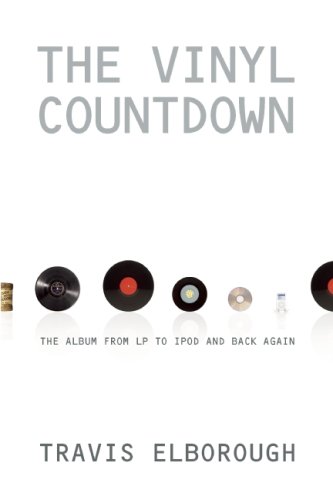Okay, so the title triggers unbidden memories of a song most of us would rather forget — and may create the impression that the book is about a format whose time came and went 20 years ago — but trust me, if you consider yourself any kind of music geek, you need to get your hands on a copy of Travis Elborough’s The Vinyl Countdown: The Album from LP to iPod and Back Again. I went in expecting a book-length defense of vinyl, but Elborough’s really up to something different here: Over the course of the book’s 480 pages, he leads the reader back through the history of the long player itself — from 78 to 33 to 8 (track) and onward, all delivered from a chatty first-person perspective and dotted through with various footnotes, personal anecdotes, and observations. If that seems like a lot of paper for a single subject, it is — but Elborough takes an impressively wide approach, beginning by circling around the hows and whys of the long player’s creation and finishing right around the time Axl started crawling up his own ass for Chinese Democracy.
It can be a bit of a slog, but it’s fascinating stuff; you could devote an entire book, for instance, to the “speed wars” that erupted when Columbia debuted the 33 1/3 LP in 1948. Elborough kicks things off with a description of the press demonstration at which Columbia president Edward Wallerstein stood next to an eight-foot stack of 78s, holding an armload of 33s, and proceeded to stun the assembled journalists into silence by contrasting the older format’s four-minutes-a-side limit with his company’s new “Revolutionary Disk Marvel,” capable of playing an entire 22-minute symphony without making the listener get up off his ass to flip it over. This introductory section is filled with fascinating tidbits about the 33’s first few unsteady steps, but it’s just a primer — before long, Elborough is off and running with in-depth looks at what the LP meant for everyone from the avid music collector (the expanded time limits of the new format made building a personal library much more affordable) to Frank Sinatra (no LP, no concept album — and no In the Wee Small Hours of the Morning).
Elborough also devotes sections to the ways the album impacted various genres, including jazz — which grew to fill the format with the exhaustive instrumental workouts we’re now familiar with — and comedy records, which basically wouldn’t exist if the LP hadn’t come along. He traces the album’s rise against the arcs of dozens of careers: Dylan, the Beatles, the Stones, Mitch frigging Miller. Ther is, of course, a section that discusses the LP-fueled advent of prog — hey, can’t win ’em all — but lest you think the album only encouraged musical wanking, Elborough fills you in on the ways the format impacted punk, power pop, and singer/songwriters.
He also devotes plenty of space to vinyl’s successors, detailing the hissy birth of the cassette, the phenomenal early success of the 8-track — which, much to my astonishment, was being made as late as 1988 — and, of course, the eventual ubiquity of the CD, and all the ways that affected the listening process, from fidelity to sequencing. Sold yet?
As I said, it can be a bit of a dense read; most music fans probably aren’t omnivorous enough to make it through every section without skimming (Michael Fortes might be the only person I know who conceivably cares about Mitch Miller and the Ramones). But Elborough helps move things along with humorous asides — at one point, he refers to Eddie Condon and Pee Wee Russell as “two veterans from the 1920s Chicago jazz scene whose names are best not uttered around stoned adolescents” — and frequently fascinating footnotes, such as the one that details the spectacular rise and fall of Gene Clark’s solo debut for Asylum. Pick yourself up a copy, block out some time to get lost in its many grooves, and thank me later.

 Travis Elborough – The Vinyl Countdown: The Album from LP to iPod and Back Again (2009, Soft Skull)
Travis Elborough – The Vinyl Countdown: The Album from LP to iPod and Back Again (2009, Soft Skull)![Reblog this post [with Zemanta]](http://img.zemanta.com/reblog_e.png?x-id=0048b7d7-43ee-46f0-b42b-7a6a35c5e833)



Comments